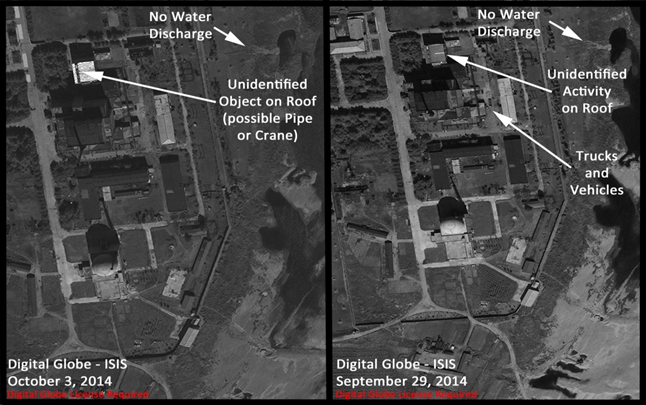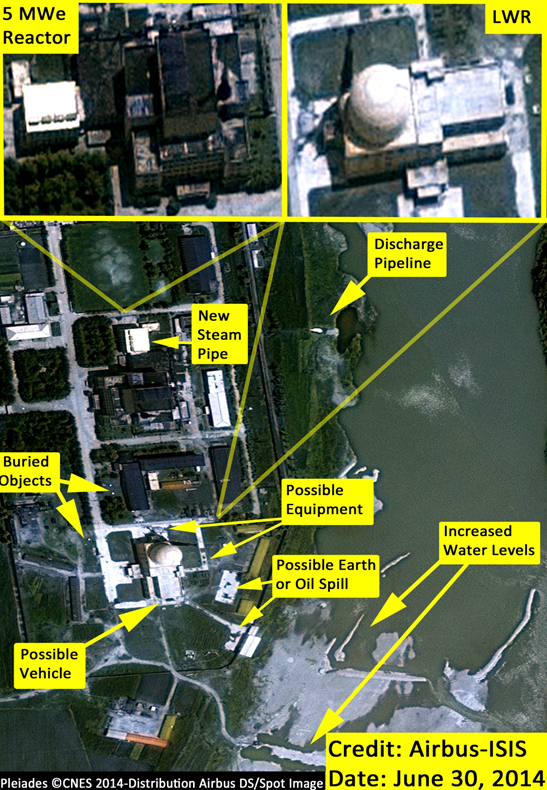Reports
ISIS Response to South Korean Foreign Minister’s Comments on Yongbyon
by David Albright and Serena Kelleher-Vergantini
October 10, 2014
On October 3, 2014, ISIS published an Imagery Brief on the status of North Korea’s Yongbyon 5MWe reactor, concluding that the reactor appeared shut down for maintenance or partial refueling. Analysis of a new October 3, 2014 Digital Globe image is consistent with that finding (see figure 1).
However, shortly after the release of the October 3 Imagery Brief, South Korea’s Foreign Minister Yun Byung-Se, in response to a question about the ISIS analysis, claimed that “many still believe that (the nuclear reactor) continues to be in operation.”1 ISIS would like to highlight that although these assessments appear contradictory, they are not.
ISIS’s assessment of a possible partial or total shutdown of the reactor for maintenance or partial refueling does not imply that the reactor has been permanently shut down. Based on discussions with officials, it is likely that Minister Yun Byung-Se was referring to the long-term operational status of the Yongbyon reactor, not what could be short-term halts in its operation. In that regard, the ISIS assessment did not conclude that the reactor is permanently shut down. It would be expected to restart and evidence of that restart would be water discharged from the reactor’s secondary cooling system.
The Foreign Minister’s statement followed press reporting of two actions by the IAEA that focused worldwide attention on the restarting of this reactor.2 In late September 2014, the IAEA General Conference passed a resolution strongly deploring North Korea’s restarting of this reactor. Earlier that month, the IAEA reported that it had concluded that the reactor had restarted. The political condemnation of the reactor’s restart in September, however, does not mean the restart happened then. It occurred months earlier. Moreover, short-term halts in the reactor’s operation do not affect the significance of that condemnation.
As explained in the October 3 ISIS brief, since September 2013, ISIS has published several Imagery Briefs showing the on-going operation of the Yongbyon 5 MWe reactor (see ISIS Imagery Briefs with imagery dated September and December 2013, as well as April and June 2014). These assessments were based on the presence of either steam venting from the reactor’s turbine building or water being discharged into the river through a pipeline buried east of the reactor.
However, in imagery dated August 27, September 29, and most recently October 3, 2014 both these signatures are missing (see figures 1 and 2; figure 3 shows the water being discharged). There is no steam venting from the turbine building and no water is being discharged from the secondary cooling system’s discharge pipeline. ISIS also found no evidence indicating that the discharge pipeline for the 5 MWe reactor’s secondary cooling system has been relocated. If North Korea had made the decision to relocate the discharge piping, evidence such as a new discharge location or excavation related to the laydown of new piping should have been visible. Although ISIS has not identified any such activity, we will continue to monitor for this possibility.
ISIS emphasizes that the precise reason for this shutdown is still unknown. It appears early for North Korea to discharge all the irradiated fuel in the reactor in order to chemically separate the contained plutonium for use in nuclear weapons. However, it is possible that North Korea is carrying out a partial refueling of the reactor’s core, such as replacing failed fuel rods. Alternatively, it is possible that North Korea has shut down the reactor for maintenance or renovation purposes. Unidentified activity is taking place on the roof of the reactor’s turbine building. In the most recent image (see figure 1) an unidentified object, possibly a pipe or small crane, is visible on the roof of the reactor’s turbine building. Finally, one long open bed truck was spotted in front of the reactor on September 29, 2014. Several other smaller vehicles are present near the reactor as well.



1 “South Korea says DPRK’s nuclear reactor in operation,” Xinhua News Agency, October 7, 2014, http://www.globalpost.com/dispatch/news/xinhua-news-agency/141007/skorea-says-dprks-nuclear-reactor-operation. 2 Implementation of the NPT safeguards agreement between the Agency and the Democratic People’s Republic of Korea, GC(58)/RES/15, September 26, 2014, http://www.iaea.org/About/Policy/GC/GC58/GC58Resolutions/English/gc58res-15_en.pdf.

 twitter
twitter